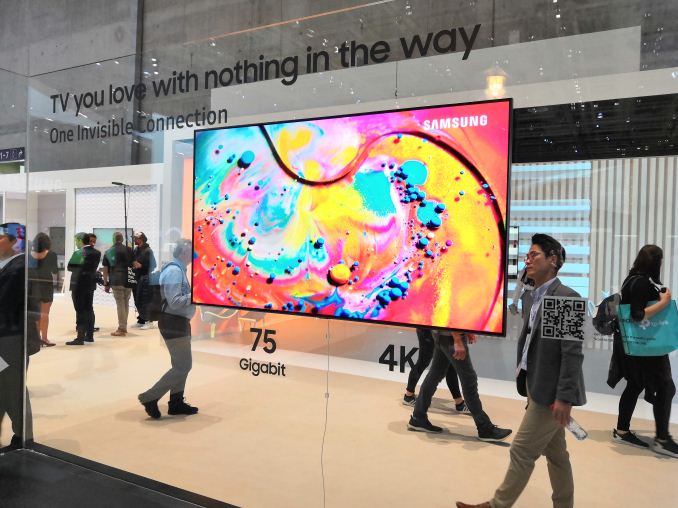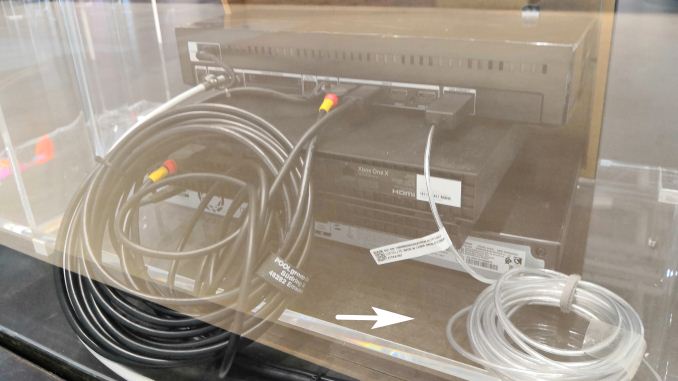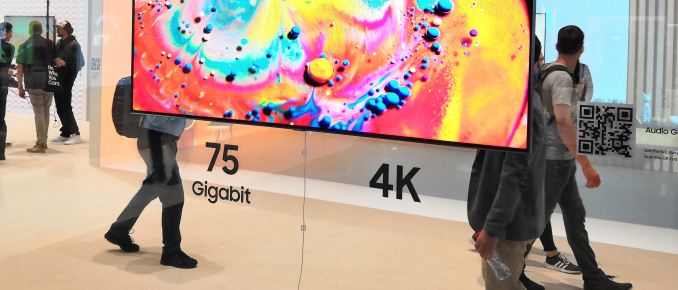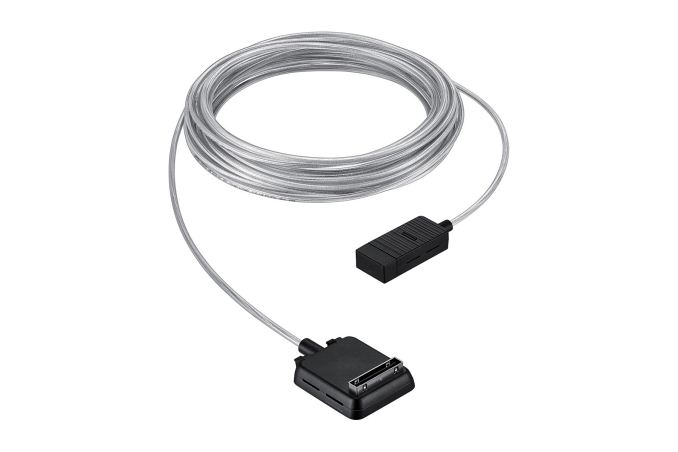Samsung’s One Invisible Connection: 75 Gbps and 230W in a Ultra Thin Cable
by Ian Cutress on September 13, 2018 2:00 PM EST- Posted in
- TV
- Samsung
- Trade Shows
- IFA 2018
- QLED

This perhaps isn’t news, but there was something super amazing that I saw on the show floor at IFA this year that I wanted to write about. Despite writing about the technology industry for nearly ten years, I still like to pace around a show floor to find new and exciting things. After bypassing room upon room of ovens and carbon-fibre fridges, I was stunned to be introduced to Samsung’s One Invisible Connection. This is a tiny thin cable that seems to do everything.
Everyone dislikes cables. If we could transmit data wirelessly, and transmit power wirelessly, I’m sure I speak for most people and say that our lives would be far less cluttered if we could do away with cable messes. Samsung’s One Invisible Connection, in turn, aims to simplify everything. In one small cable they are able to power a full-sized 4K display (up to 230W) as well as transmit 4K video (75 Gbps). A picture says a thousand words:
A cable supporting that much data and that much power, to me, seems crazy. Apparently Samsung is shipping this on all their high-end QLED displays already, and it connects to a host box which deals with power and the video inputs, such as a Blu-Ray player, console, or cable TV. (ed: for anyone wondering, the cable appears to be an optical cable with additional wires for carrying high voltage DC power)


Cable indicated by white arrow
I still can’t get over how thin this cable is. It’s as thin as my 65W charger cable for my laptop. And Samsung offers the cable in both 5m and 15m lengths (~16.5ft and ~50ft), so it's not a short-run cable either. I asked why it wasn’t a standard across everything, and the reason is because of the high cost. Not the cost of the cable, mind you, but rather the extra hardware that goes into the device before the TV, and into the TV itself. I tried to take a picture of the back of the TV, but it didn’t come out well. This is the danger of having a Perspex booth to demonstrate the technology.
Well like I said, it isn’t new. But it is something that made me a bit speechless.












30 Comments
View All Comments
casperes1996 - Thursday, September 13, 2018 - link
Not to mention the effeciency lossValantar - Friday, September 14, 2018 - link
HDMI cables are still rather thick and difficult to handle, though, so this is a far more elegant solution. I like the idea of using high-voltage DC, and frankly, moving the I/O of the TV to a box somewhere inconspicuous is ... the only natural thing with LCD TVs. Now we just need an open standard for this.PeachNCream - Friday, September 14, 2018 - link
Yeah, I agree that HDMI cables lack flexibility and are a bit too thick to make running them where you want them to go an easy prospect.Santoval - Saturday, September 15, 2018 - link
While it is more efficient to convert microwaves than visible light to electricity (due to the single wavelength of microwaves vs the wide wavelength of light, which allows for the microwave detector at the charging device to work at resonance with the microwaves), it is impossible to construct a compact and strong enough charger & emitter and the required detector and microwave - electricity converter in a TV to supply 250W.Even if, somehow, it could be done, you would burn 850 - 1000W for each 250W the TV consumed.
Santoval - Saturday, September 15, 2018 - link
p.s. A conductive charger is also out of the question, since they do not work with interface gaps beyond 2 - 3 cm.Santoval - Saturday, September 15, 2018 - link
p.s.2 (Jesus, add an edit button already) I meant *inductive* charger.FreckledTrout - Thursday, September 13, 2018 - link
They say one invisible connection but I can still see it.PeachNCream - Friday, September 14, 2018 - link
Samsung Marketing Department Response - If you close your eyes, it'll disappear!WatcherCK - Thursday, September 13, 2018 - link
Only a matter of time before tech sites will be reviewing and bench marking appliances (if nothing else other than to see how abysmal the devices security is, and what framerate your fridge will run IoTmark?) You will need to move into a bigger space to store appliances awaiting testing but on the plus side unlimited cold beers!Are Samsung the type of company that would licence their tech as an open standard or are they more Dolby in their licencing?
Also how mature are wireless video transmission protocols? If you had 4k HDR1000 capable WiDi and an inductive power interface for the display panel then to wires at all (but just like the old CRT televisions dont put your heads too close to the tv kids 😏)
boozed - Thursday, September 13, 2018 - link
"I tried to take a picture of the back of the TV, but it didn’t come out well. This is the danger of having a Perspex booth to demonstrate the technology."Invest in a polarising filter for your camera.